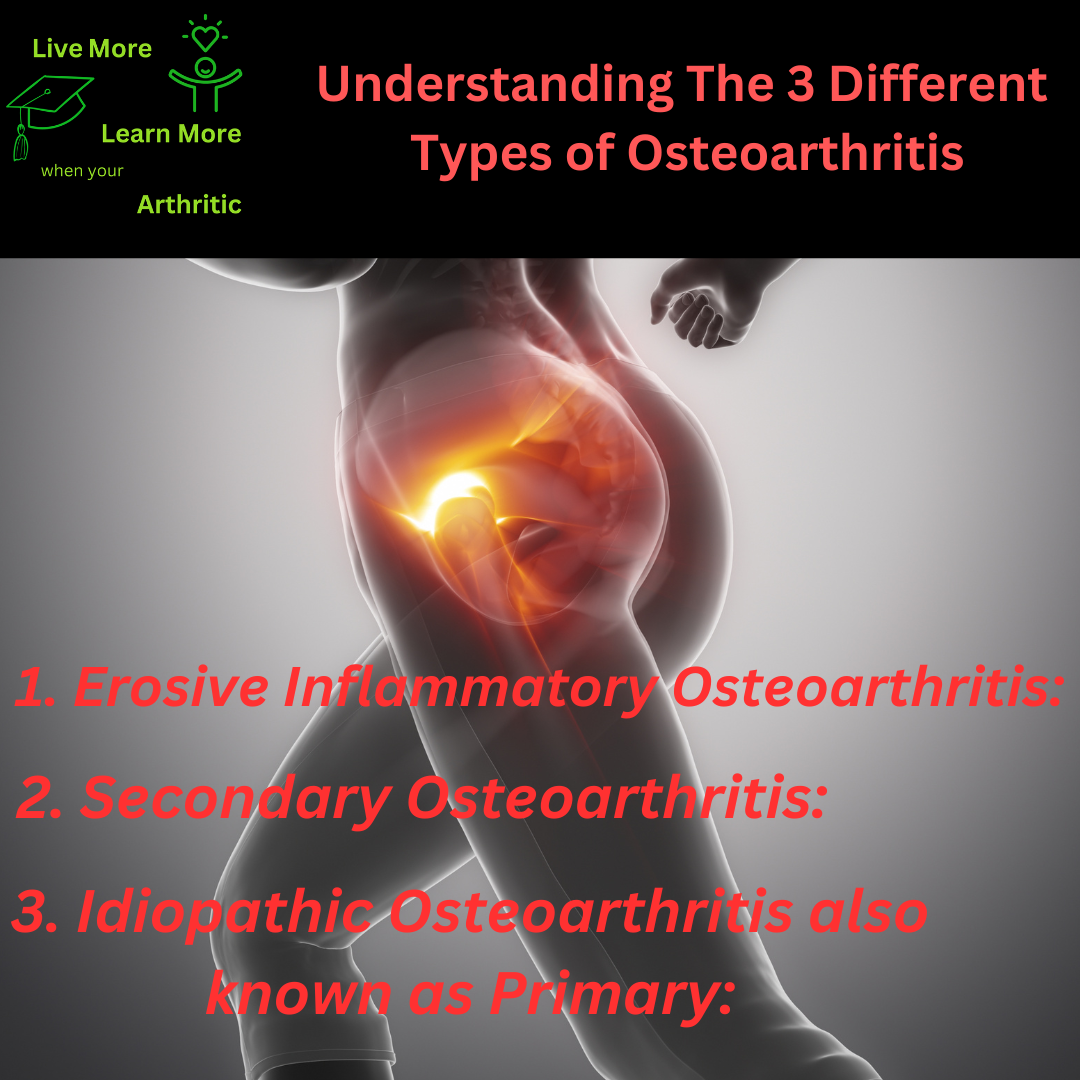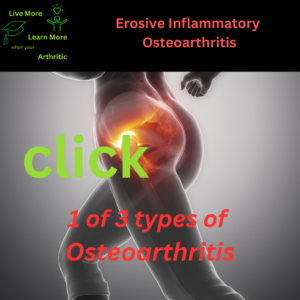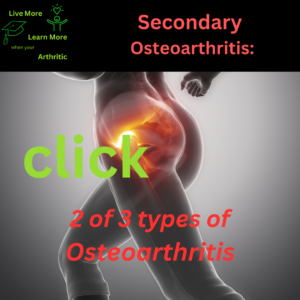
Understanding The 3 Different Types of Osteoarthritis
Understanding Different Types of Osteoarthritis
Osteoarthritis (OA) presents in various forms, each with unique characteristics influencing diagnosis and treatment. Let’s merge the comprehensive list and the detailed exploration of Erosive Inflammatory Osteoarthritis, Secondary Osteoarthritis, and Idiopathic Osteoarthritis to provide a comprehensive understanding:
Here are the links to each remaining Osteoarthritis article covered in this 4 part series:
- Erosive Inflammatory Osteoarthritis: 1 of 3 types of Osteoarthritis
- Secondary Osteoarthritis: 2 of 3 types of Osteoarthritis
- Idiopathic Osteoarthritis: 3 of 3 types of Osteoarthritis

1. Erosive Inflammatory Osteoarthritis:
- Likelihood of Remission: Less common compared to other types of osteoarthritis.
- Average Age of Onset: Typically affects individuals in their 50s to 60s.
- Sex Relation: More prevalent in women.
- Complications: Joint deformity and erosion of cartilage.
- Causes: Genetic predisposition and immune system dysfunction.
- Quality of Life and Lifespan: Can impact mobility and quality of life; lifespan is generally not shortened.
- Major Symptoms: Joint pain, swelling, stiffness, and warmth.
- Triggers: Genetic factors and inflammatory processes.
- Distinguishing Features: Characterized by joint inflammation with erosive changes visible on imaging, often affecting the interphalangeal joints of the hands.
- Diagnostic Differences: Diagnosis involves assessing clinical presentation, imaging findings, and exclusion of other inflammatory arthritic conditions like rheumatoid arthritis.
- Treatment Approach: Includes NSAIDs, DMARDs, and physical therapy to manage pain and inflammation.
- 3 percent of people develop erosive osteoarthritis.
- Click Photo to your right
Erosive Inflammatory Osteoarthritis: Number 55 on the list of 100 types of Arthritis

2. Secondary Osteoarthritis:
- Likelihood of Remission: Dependent on the underlying cause; less likely compared to primary osteoarthritis.
- Average Age of Onset: Varies based on the underlying condition; can occur at any age.
- Sex Relation: Equally affects men and women.
- Complications: Accelerated joint degeneration due to underlying conditions (e.g., previous injury, obesity).
- Causes: Previous joint injury, obesity, or other joint-related conditions.
- Quality of Life and Lifespan: Impact on quality of life depends on the severity of the underlying condition; lifespan is generally not affected.
- Major Symptoms: Joint pain, stiffness, limited range of motion.
- Triggers: Previous joint trauma or injury.
- Distinguishing Features: Develops due to underlying joint trauma, injury, or related conditions, commonly affecting weight-bearing joints.
- Diagnostic Differences: Diagnosis relies on medical history, physical examination, and imaging studies to identify the underlying cause.
- Treatment Approach: Focuses on managing the underlying cause alongside standard osteoarthritis management strategies.
- Click photo to you left
Secondary Osteoarthritis: Delving into Causes, Impacts, and Management

3. Idiopathic Osteoarthritis also known as Primary:
- Likelihood of Remission: Rare; typically a chronic condition.
- Average Age of Onset: More common in older adults, typically after age 50.
- Sex Relation: Slightly more common in women.
- Complications: Joint stiffness, loss of function, and disability.
- Causes: Unknown; likely a combination of genetic, environmental, and mechanical factors.
- Quality of Life and Lifespan: Can significantly impact daily activities and quality of life, especially in advanced stages.
- Major Symptoms: Joint pain, stiffness, crepitus, and swelling.
- Triggers: Aging, genetic predisposition, joint overuse or trauma.
- Distinguishing Features: Primary osteoarthritis with no identifiable cause beyond age, genetics, and mechanical factors.
- Diagnostic Differences: Diagnosis involves evaluating clinical presentation, imaging findings, and excluding secondary causes.
- Treatment Approach: Focuses on pain management, improving joint function, and lifestyle modifications.
- Most common form of Osteoarthritis
Osteoarthritis: Number 1 on the list of 100 types of Arthritis
 General Characteristics and Interrelationships:
General Characteristics and Interrelationships:
- Possible Complications: Joint deformity, loss of function, chronic pain, and disability.
- Autoimmune or Not: Osteoarthritis primarily involves degenerative changes in joint structures and is not considered autoimmune.
In summary, while each type of osteoarthritis shares common symptoms like joint pain and stiffness, they differ in their causes, diagnostic criteria, and treatment approaches. Understanding these distinctions is vital for accurate diagnosis and tailored management to optimize outcomes and improve overall well-being for those affected by these conditions.
Enjoy read 4 more articles about Osteoarthritis:

